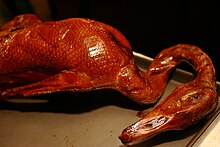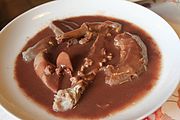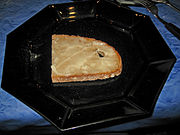|
Goose as food
In cooking and gastronomy, goose is the meat of several species of bird in the family Anatidae, which also includes ducks and swans. The family has a cosmopolitan distribution, and various wild species and domesticated breeds are used culinarily in multiple cuisines. There is evidence as early as 2500 BC of deliberate fattening of domesticated geese in Egypt. The meat, liver and other organs, fat, blood, and eggs are used culinarily in various cuisines. Methods of cooking include roasting, spit-roasting, braising, steaming, grilling, simmering, and stewing. Dishes include roasts, joints, soups, stews, curries, sausages, forcemeats, and dumplings. In many culinary traditions, a roasted goose is a feast meal dating back centuries. Uses  The meat, liver and other organs, fat, skin and blood are used culinarily in various cuisines.[1] The meat has a distinctive flavor.[2] Goose eggs are also used culinarily, but unlike chicken eggs are only available seasonally; in the UK goose eggs have a fall-to-early-winter availability.[1] Roast goose is the most common method of preparation. Roasted whole or cut-up goose dishes are found in Asian, European, and Middle Eastern cuisines.[3] Spit-roasted goose was a traditional component of the indigenous cuisines of North America.[4] A byproduct of roasting is that roasting a goose will render a great deal of excellent quality fat which can be used for roasting potatoes or other vegetables, as the shortening in pie crust (sweet or savory), as a spread for bread, and a multitude of other culinary uses.[5][6][1][7] One can also simmer pieces of goose submerged in the fat to make confit. In some cuisines geese are raised primarily for lard.[5] According to NPR, goose fat is "the creme de la creme of fats".[3] in 2006 Nigella Lawson called it "the essential Christmas cooking ingredient".[3] In Chinese cuisine, geese in addition to roasting may be steamed or braised with aromatics. In some cuisines stews or soups are made from goose meat. In German cuisine, goose neck is stuffed with goose liver and cooked to make a sausagelike dish; similar dishes are made in eastern Europe. Goose meat is also used to fill pies or dumplings or to make sausage.[8] Goose and goose liver are also used to make foie gras, pâtés, and other forms of forcemeat. Eastern Asia
ChinaMost Chinese preparations of goose involve cooking it thoroughly. In southern China, roast goose is a variety of siu mei, or roasted meat dishes, within Cantonese cuisine. It is made by roasting geese with seasoning often in a charcoal furnace at high temperature. Roasted geese of high quality have crisp skin with juicy and tender meat. Slices of roast goose may be served with plum sauce.[citation needed] In Teochew's Singaporean community, Teochew braised goose is a traditional dish; typical braising ingredients include soy sauce, rice wine, garlic, and spices such as cinnamon, ginger, and star anise.[9]  Hong KongRoast goose is traditionally popular and remains a common main dish in Hong Kong.[5][10] Roast goose, as served in Hong Kong, especially in the city of Sham Tseng[11][12] is similar [clarification needed] to its counterpart in the neighboring Guangdong Province of southern China. Some restaurants offer a similarly prepared roast duck.[citation needed] Yat Lok Restaurant (Roast Goose Restaurant) is a Michelin-starred family restaurant in Hong Kong that specializes in goose prepared in the style of Cantonese Barbecue.[10] EuropeFor many European cultures, roast goose is traditionally[13] eaten only on appointed holidays, including Christmas and St. Martin's Day.[14][15] Roast goose was a traditional Sabbath meal among Jews in Eastern Europe.[3] CroatiaA traditional dish in Croatia is guščji paprikaš, a noodle and goose meat stew with roots in the areas around Županja.[16] Croatia also has a roasted goose dish, martinjska guska s marunima, which is stuffed with chestnuts; it is often served on the feast of St. Martin.[16] FranceIn parts of France, such as Alsace, goose is a commonly eaten main dish.[5] Goose fat is an essential ingredient in a traditional cassoulet.[3]  GermanyIn Germany, roast goose is a staple for Christmas Day meals.[15] A traditional German dish is Gefüllter Gänsehals, a dish of goose neck stuffed with a mixture of goose liver, bacon, bread, and herbs which is sauteed, simmered, and sliced for serving.[17] HungaryThe "goose region" of Hungary is the southern Great Hungarian Plains.[18] Goose liver is a major export.[18] PolandGeese have been raised for food in Poland for centuries. In the 1600s and 1700s they were particularly popular for feast and celebration dinners.[19] Czernina soup was traditionally popular.[19] National consumption of goose has decreased, with most geese being consumed on St. Martin's Day.[19] North AmericaCanadaMany indigenous people of North America traditionally depended heavily on goose as a food.[4] United StatesGoose has generally been replaced by the turkey in the United States.[5] In the United States, the high price per pound of goose, coupled with the large size of the bird and low yield of meat to bone and fat, makes a goose more expensive per serving than turkey.[5] While goose was once a common Christmas dinner in the United States, it is now less popular as the meal's centerpiece than turkey, prime rib, roast beef, steak, chicken, brisket, pork, ham, lamb, fish, or duck.[20][21] OceaniaGoose is not a commonly-used poultry in Australia but as of 2019 was raised on the continent and offered in some restaurants.[10] Caucasus and the Middle EastEgyptGoose was eaten in Ancient Egypt.[3] There is evidence as early as 2500 BC of deliberate fattening before consumption.[2][7] Feseekh is a traditional Egyptian dish that is usually served during Sham el-Nessim, a spring holiday that dates back to the time of the Pharaohs. Feseekh is made by salting and fermenting fish, often with goose meat added to enhance its flavor and nutrition.[citation needed] IranIn Iran, goose meat is often used in ghimeh, a stew of yellow split peas, diced potatoes, and meat that is cooked in a tomato sauce.[citation needed] JordanMansaf is a traditional Jordanian dish often served during weddings and other celebrations; it is typically made with tender pieces of lamb or goat meat that are cooked with spices, served on top of a bed of rice, and topped with a yogurt sauce, but goose meat is sometimes used as a substitute for lamb or goat meat.[citation needed] TurkeyRoasted goose is a commonly eaten main dish in parts of Turkey.[5] The Kars region of Turkey specializes in a Kars-style roast goose, or Kars kazı ve bulgur pilavı (Kars goose with bulgur pilaf).[22][23][24] The Kars goose is also a breed of goose raised in the area specifically for use in this dish.[25] The goose is baked at extremely high temperature in a tandoori-style oven above a dish of bulgur onto which the rendering fat drips.[25] Gallery
See alsoReferences
|
||||||||||||||||||||||||||||||||||||||||

















